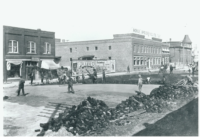Crowsnest Pass at a crossroad
By Lethbridge Herald Opinon on August 6, 2020.
Allan Garbutt
I was born and raised in southern Alberta, and first explored the upper Oldman River more than 60 years ago. The Oldman was a favourite recreation area until school and work took me away.
I returned as a medical doctor in 1992 and have lived here ever since. My return coincided with some of the most economically challenging times Crowsnest Pass has seen. Between bankruptcies, strikes and lockouts, almost no coal miner in the area worked full-time for several years. Many hardly worked at all. It was a tough lesson in the risk of being a one-industry town.
As the years passed, I watched as Crowsnest Pass lost much of its retail and service base. Throughout the time, Crowsnest Pass Council steadfastly sought more mining jobs. And it cheered when the Coal Mountain mine (close by in B.C.) was expanded. More recently, it expressed pleasure at the prospect of a new mine being proposed for the headwaters of the Crowsnest River (within the Oldman watershed).
When the Grassy Mountain Coal Project (in the upper Oldman watershed) was first proposed, I was generally supportive. The idea of more and better jobs for my patients was enticing.
As I gained a clear look at the actual proposal, however, doubts began to develop. One of the more dramatic shifts came at a public information session where the engineers did not seem to see a connection between ground water and surface water. I wondered what else was not being thoroughly assessed.
When I read the company’s Environmental Impact Assessment (EIA), I became more concerned. In my pre-medical career, I wrote and reviewed EIAs. The Grassy Mountain submission that I read in depth represented its eighth attempt to meet an acceptable EIA standard. It still contained glaring deficiencies, things that in my previous career I would have been expected to resolve in an early draft. What I read looked like a document that had been thrown together by a group that did not believe it had to submit a polished proposal. Again, recall that I spent years reviewing papers written by everyone from undergraduate science students to experienced environmental professionals.
In the months since my retirement from medical practice in Crowsnest Pass, I have conducted a detailed review of the likely impacts of the proposed Grassy Mountain Coal Project. What I have learned is disturbing, to say the least.
The mine, if permitted, will degrade both the water quality and the water quantity in the Crowsnest River and in the upstream tributaries that flow through the proposed project. The proposed impoundments (tailings ponds) are a huge concern, underscored by the U.S. Environmental Protection Agency’s report that all impoundments leak. Many fail. When they do fail, they spill huge amounts of waste into the downstream waterways. In the best case, a soup of toxic chemicals will be delivered to Albertans. In the worst case, the debris flow will engulf a hospital, shops and homes before the toxic soup impacts other Albertans.
Waste rock from mining releases selenium for decades. Despite assurances from the mine developers, no has ever successfully remediated that leachate. Teck has spent literally billions of dollars over many years trying to handle its selenium problem. Selenium has destroyed fisheries in many locations in the U.S., and is the likely culprit in the recently documented collapse of the trout fishery in the Elk River near Fernie and Sparwood.
There is no reason to believe a new mine in Crowsnest Pass can deliver a different result. Selenium will settle in the sediment of the Oldman Reservoir, where it can remain dangerously high for decades after mining ends. Its devastating impacts will be concentrated up the food chain, until it reaches the top predators such as trout.
People who live near coal mines face serious health risks. Negative health impacts start at conception and continue until death. The toxic effects can only be seen at the population level, but they are dramatic and sometimes fatal for people living many kilometres from a mine. Inhaling coal mine dust, a single example, is a known health hazard.
A recent court decision addressing a proposed coal mine application in New South Wales, Australia sums up the overly optimistic cost/benefit analysis that seems common to many coal development proposals. There, the court found that the project proponents dramatically overstated the numbers of new employment opportunities. Similarly, the proponent’s claims for increased local spending could not be supported.
The court noted, too, that a mine effectively closes the door to other economic opportunities. Having a mine means no tourist industry and no quality-of-life in-migration. The Australian court decision mirrors the American experience and reveals this: Coal mines cause – they do not relieve – poor living conditions.
If the proposed Grassy Mountain Coal Project is approved and developed, there will be limited benefits for the local area. Most of the financial benefits will flow to those who live elsewhere, with much of it going to Australian owners. Even those benefits that do come to Crowsnest Pass will last only for the life of the mine, while the costs, huge, will persist for decades, perhaps for centuries.
Crowsnest Pass, instead of clinging to its troubled mining past, should embrace the future and reject the mine. The future for the community lies in its profound natural beauty and outdoor appeal. That potential is acknowledged in the Alberta Government tourism plans, which lie in stark contrast to its obvious support for the mine proposal.
The people of Crowsnest Pass and Alberta should look for its future, not in the coal towns that could not or would not adapt (such as Nordegg Cadomin, and the Coal Branch). In a progressive Alberta, we should look at the multiple Canadian and American communities that have done very well by embracing and welcoming a new future reflected in quality-of-life living and the appeal of outdoor tourism. In this light we can look at Red Lodge and Whitefish in Montana, and to nearby Canmore. It was a dying coal town until the tourists arrived. Even Drumheller now relies far more on “dinosaur tourism” than its former mines.
Crowsnest Pass and Alberta must look forward, not backward, to embrace a prosperous future. It does not need nor will it benefit from the proposed Grassy Mountain Coal Project.
Allan Garbutt was born and raised in southern Alberta. He holds a Ph.D. in wildlife biology and worked in the consulting field for several years before changing career paths and working in Crowsnest Pass as a rural physician for more than 26 years, before retiring last fall. He and his wife currently share their small ranch in the Porcupine Hills with an assortment of ranch livestock and forage crops.
21-20




